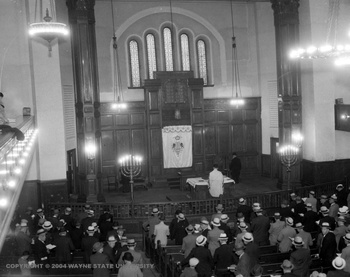Late 1800s & Early 1900s
The Jewish quarter, a busy place in 1896, was formed by Monroe, Watson, Brush, and Orleans streets. Hastings Street, now covered by I-75, was the center of activity, as it was in the overlapping Black Bottom and Paradise Valley.
Housing conditions were crowded but not terrible. Many structures in Detroit's Russian-Jewish quarter were built within 10 or 20 years of 1900 by German investors.
1920s
In the 20s, Jewish residents fled Hastings Street for Twelfth Street on the city's West Side.
1930s
 Beth David, a synagogue on Detroit's west side near 14th and Elmhurst. Photo from the 1930s.
Beth David, a synagogue on Detroit's west side near 14th and Elmhurst. Photo from the 1930s.
1940s
The center of Detroit's Jewish population in the 1940s was along Twelfth Street, between Linwood and Hamilton north of Grand Boulevard. Unlike the rest of the city, most of the buildings were apartments or two-family houses, and most were rented. The area held over 30 synagogues.
African-Americans started moving into the neighborhood in the late 1940s. Unlike some of the defended neighborhoods in the city, perhaps because of religion, and perhaps because of the low number of homeowners, Jewish groups did not react violently.
1960s
Jewish residents left the city for the suburbs, particularly Oak Park and Southfield.
Today
The Isaac Agree Downtown Synagogue and Reconstructionist Congregation of Detroit both hold regular services. The Downtown Synagogue is the only free-standing Jewish place of worship in the city.
Former synagogues have been repurposed. The former Temple Beth El at 3424 Woodward Avenue is now Wayne State University's Bonstelle Theater. The website http://Shtetlhood.com has an extensive list of Detroit's synagogues and shuls.
Pages tagged “synagogue”
Sources
Sugrue, Thomas. The Origins of the Urban Crisis: Race and Inequality in Postwar Detroit.
Tishman, Maggie. Saving Detroit’s Last Synagogue in Next American City, Jan 23 2009.
Zunz, Olivier. The Changing Face of Inequality: Urbanization, Industrial Development, and Immigrants in Detroit, 1880-1920. University of Chicago Press, 2000.


